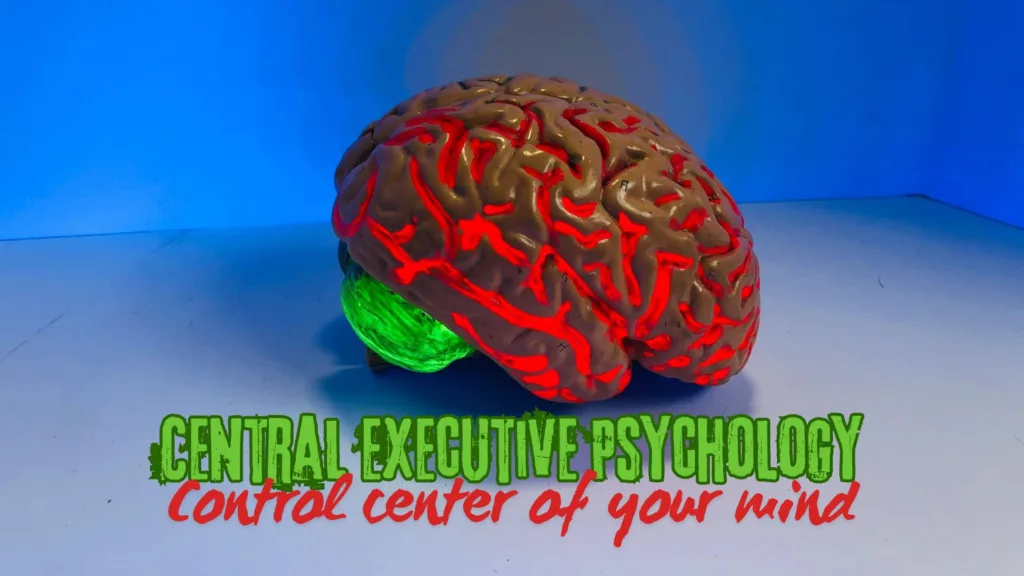Alan Baddeley and Graham Hitch introduced the working memory model in 1974, where the central executive plays a crucial role. This model changed how we think about short-term memory by showing it as an active system with several parts, instead of just one simple storage area. The central executive is very important because it manages and coordinates different mental tasks. This article will explain what the central executive does, the theory behind it, the brain areas involved, and why it’s important for understanding how we think.
What is Central Executive in Psychology?
The central executive in psychology is like the brain’s manager. It helps us focus, switch tasks, and make decisions. For example, when solving a math problem, it keeps our attention on the task and changes strategies as needed. Driving and talking to someone helps us pay attention to the road and the conversation. It works with other parts of our memory to handle different types of information, making sure everything runs smoothly in our minds.
Key Parts of the Working Memory Model
he working memory model has four main parts that help us process and use information:
- Central Executive:
- Function: This is like the brain’s manager. It focuses attention, switches between tasks, and makes decisions.
- Example: When solving a math problem, it helps you focus on the task and try different ways to find the answer.
- Phonological Loop:
- Function: Handles verbal and auditory information, like words and sounds.
- Example: When you repeat a phone number to yourself to remember it, you’re using this part.
- Visuospatial Sketchpad:
- Function: Deals with visual and spatial information, like what you see and where things are.
- Example: When you picture a map in your mind to find your way, you’re using this part.
- Episodic Buffer:
- Function: Combines information from different sources into a single memory.
- Example: When you remember a fun day out, it pulls together sights, sounds, and feelings into one memory.

Neurological Background
Research on how the brain works has found certain areas that are important for the central executive’s job. One key area is the prefrontal cortex, especially a part called the dorsolateral prefrontal cortex (DLPFC). This part is really active when we’re doing tasks that need a lot of thinking, like solving problems or switching between tasks. Brain scans like fMRI and PET show that it lights up when we’re using our brains a lot.
Another important area is the anterior cingulate cortex (ACC), which helps us spot mistakes and handle conflicts. It’s crucial for the central executive to keep everything running smoothly. Also, parts like the parietal cortex and the basal ganglia help with paying attention and remembering things. Together, these brain areas support the central executive in managing our thinking processes.
Why is it important to know about it?
Understanding the central executive is really important for a few reasons:
- Growing Smarter: How well the central executive works is connected to how smart kids become. When this part of the brain improves, kids tend to do better in school and get along better with others.
- Helping with Problems: Some people have trouble with their central executive, which can lead to issues like ADHD, schizophrenia, or dementia. By knowing how it works, we can create better ways to help them.
- Teaching Better: Knowing how the central executive works can help teachers teach in ways that help students pay attention, solve problems, and handle lots of tasks at once.
- Everyday Life: It also helps with things we do every day, like planning, making decisions, and doing many things at once. Making it work better can make life easier and more enjoyable overall.
Possible Challenges
Hard to See: The central executive is like a hidden boss in the brain that we can’t directly see or measure, making it tricky to study.
Complicated: It’s like a big puzzle piece that does many jobs and works with other parts of the brain, making it tough to figure out exactly how it works.
Guesswork: Scientists have to use clues and guesses based on how people behave to understand what the central executive does.
Fancy Brain Scans: New technologies help scientists look inside the brain to see which parts are active when we use the central executive, but it’s still not easy.
Watching Growth: Scientists also study how the central executive changes as we grow up to see how it develops over time.
Team Effort: To fully understand the central executive, scientists from different fields like psychology, brain science, education, and medicine have to work together and share what they find.
Real-Life Benefits: Even though it’s tough to study, knowing more about the central executive can help us teach better, improve mental health treatments, and make daily life easier.
The central executive is a key part of how our brains work, helping us manage and organize all the different tasks we do each day. We’ve learned a lot about what it does and how it works in the brain, but there’s still more to discover. Understanding the central executive better can help improve teaching methods, medical treatments, and everyday problem-solving. As research continues, it will lead to better ways to boost our thinking skills and overall mental health.

Pingback: Maintenance Rehearsal: Repeat to Remember
Pingback: Stimulus Generalization: The Broad Spectrum of Responses